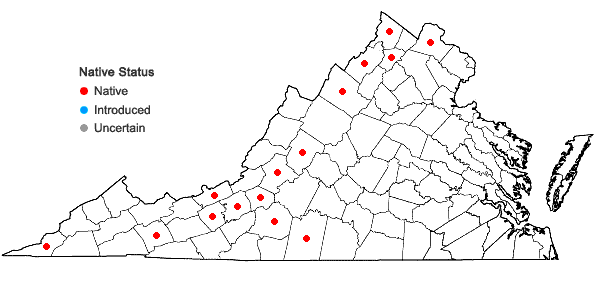Packera paupercula (Michaux) Á. & D. Löve var. appalachiana A.M. Mahoney;

Detail
- Family
- Asteraceae
- Botanical Name
- Packera paupercula (Michaux) Á. & D. Löve var. appalachiana A.M. Mahoney;
- Common Name
- Appalachian Ragwort
- Synonym(s)
- Packera plattensis (Nutt.) W.A. Weber & A. Love, in part; Senecio plattensis Nutt., in part
- Flora of Virginia Name/Status
- Packera paupercula (Michaux) A.&D. Love var. appalachiana A.M. Mahoney
- Comments
- Until recently, this taxon was treated as an Appalachian representative of the more western Packera plattensis. While the segregation of the Appalachian plants may have merit, Packera is taxonomically complex and we almost certainly have not gotten the "last word" on the complex of entities now residing infraspecifically under the umbrella of P. paupercula. In particular, the assignment of Virginia populations in 15 counties to this taxon instead of to western P. plattensis is based on a single chromosome count from one cell in one population (Montgomery Co.); the plant in question is a tetraploid, whereas plants in a w. NC population assigned to var. appalachiana are diploid. In addition, there is considerable variation in pubescence and other morphological characters just in Virginia populations that suggest the possibility of multiple origins, i.e. originating at different times, perhaps from the same taxa but from potentially different genotypes. There are many questions that need addressing by future studies, particularly additional chromosome counts and determination of ploidy level(s) from a wider sample of Virginia populations.
- Habitat
- Dry, rocky woodlands and barrens over dolostone (rarely limestone), and occasionally mafic or ultramafic rocks; in Virginia, this species appears to be a rather strict magnesiophile, associated almost exclusively with soils of consistently high magnesium and widely variable calcium content. Infrequent and local in the mountains; rare in the Piedmont.
- Native Status
- Native
To save this map, right-click (control-click for Mac users) on the map and choose "Save Image As...".


